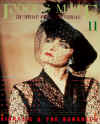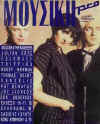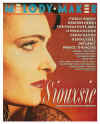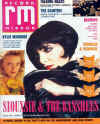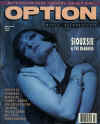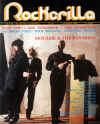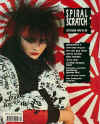|
|
MARK PAYTRESS BRINGS THE
BANSHEE’S STORY UP TO DATE, AND REPORTS ON THE BAND’S INCREASING
NUMBER OF COLLECTOR’S ITEMS, FROM PROMO COPIES OF "THE
SCREAM" TO THEIR MOST RECENT CD SINGLES
For many years, Siouxsie and the
Banshees have been the subject of much debate among rock scribes. Many
have denounced the group as an irrelevance, still sounding - and looking
- pretty much the same as they did back in the late Seventies. But this
fails to take into account the sheer uniqueness of the band’s sound
which won them such acclaim in the first place, at a time when so many
outfits were happy to become third rate Sex Pistols.
While perfecting their craft over
the past decade, the two constants - bassist Steve Severin and Siouxsie
Sioux herself - have ensured that the group’s basic characteristics
remain intact. But remaining true to their roots has not curtailed the
group’s willingness to experiment. Among the innovations was the
introduction of a string section during the early Eighties, though a
vital ingredient in the group’s development was the arrival of drummer
Budgie in 1979. It is impossible to imagine the Banshees circa 1978
delivering songs with the majesty of "Dear Prudence" or
"Cities in Dust".
RARITIES
We originally covered the history
of the group back in 1984 (issue 65). This feature will bring the
Siouxsie and the Banshees story right up to date, paying particular
attention to rarities, foreign pressings and ephemera.
Introduced by a mutual friend
Simon (who went on to form Jimmy The Hoover) at Roxy Music’s 1975
appearance at Wembley Arena, Sioux and Severin were initially inspired
by the Sex Pistols and decided to form a band in time for the 1976 Punk
Rock Festival at the 100 Club. Several months later, Track Records paid
for them to record a session which has since turned up as the
"Track Rehearsals EP" bootleg. Recorded on 12th March 1977, it
contained much of the band’s early set: "Captain Scarlet",
"Scrapheap", "Psychic" and "Bad Shape",
all of which eluded official blessing, and early versions of "Love
In A Void" and "The Lord’s Prayer", here presented as
one song.
At this time guitarist P.T. Fenton
and drummer Kenny Morris made up the quartet. Rumours that the band
recorded a demo for EMI in June appear to be unfounded and, one month
later, the group were performing with a new guitarist, John McKay,
making his debut at Shad Thames, Butler’s Wharf, London, at an Andrew
Logan/Derek Jarman party, his first appearance ‘proper’ was two days
later at the Vortex on 11th July.
An excellent example of the group
in these early stages can now be purchased officially thanks to Strange
Fruit’s excellent "Peel Session" series. A second session is
still only available on the popular "Love In A Void" bootleg,
which also boasted three (presumably) Polydor recordings, "Love In
A Void", "Carcass" and "Make Up To Break Up",
the latter still unissued officially in any form.
The band were filmed for
Granada’s "So It Goes", broadcast in November 1977,
performing "Make Up To Break Up". They also appeared in Don
Lett’s "The Punk Rock Movie", performing "Bad
Shape" and "Carcass" during the Heartbreakers tour in
July as well as backstage scenes at the Roxy in April. In fact Siouxsie
and the Banshees were scheduled to appear on "The Roxy, London
WC1" LP, issued in 1977, but while two or three songs (including
"Captain Scarlet" and a version of T.Rex’s "20th
Century Boy") were recorded, the band evidently didn’t like the
results. It was to be another year before the first Siouxsie and the
Banshees release appeared - and it was well worth the wait.
SCREAM
"The Scream" album was
preceded by "Hong Kong Garden" (premiered on ‘Revolver’ in
July) which, as well as taking the band straight into the Top 10 singles
chart, has given rise to plenty of rare editions sought after by
collectors. Promo copies, which featured beige injection-moulded labels,
fetch at least £20, while the limited run of 10,000 boasting a gatefold
sleeve are now valued at £18. One-sided 10" acetates must be worth
around £50.
Increasingly popular with
collectors are the foreign editions of the band’s single, which often
come in stunning - or in some cases, bizarre - picture sleeves. A
Japanese "Hong Kong Garden" featuring a cartoon of the band is
a fine example though it carries a price tag of no less than £40. An
Australian release sells for nearer £20, while Dutch and French picture
sleeve copies are worth no more than £15. Some Spanish copies
apparently came in a gatefold sleeve though, surprisingly, they only
seem to sell for £12 - relatively cheap! On the home front, advertising
posters for the single are well worth searching out for - already they
attract offers of around £25.
Test pressing of "The
Scream" fetch £15; a Utopia two-sided acetate is valued at £35,
wile two one-sided US Artisan Sound Studio acetates are worth £75. Some
import copies boasted the addition of "Hong Kong Garden".
While the follow-up 45, "The
Staircase (Mystery)", failed to emulate the success of the debut,
it nevertheless was more characteristic of the band’s sound, with its
dark bassline, razor-edged guitar and precision drumming coated with the
sort of female vocals one had previously only dreamed of. Dutch picture
sleeve copies seem to attract the best prices of around £25; again
Spanish copies are cheaper, valued at near £10.
"Playground Twist",
surely one of the Banshees’ greatest moments, has given rise to few
collector’s items, though during work on a second LP, "Join
Hands", the band re-recorded a cut from "The Scream",
"Metal Postcard", in German, which has given rise to some
confusion amongst fans. Originally released in Germany, good sales on
import prompted Polydor to give the song a full UK release - albeit with
the same catalogue number. However, copies can be distinguished in
several ways; the European edition came with a continental centre while
the red label stated that the record Was ‘Made In West Germany’ and
lists the title as "Mittageisen" lasting for ‘4.05’. It
also bears a German copyright notice. UK pressings came with a solid
centre while the silver label is marked ‘Made In England’. The song
is titled "Mittageisen (Metal Postcard)", and no time is
given.
Most of the confusion surrounds
the sleeve. The UK edition (actually a double A-side) list both tracks
on the front sleeve, omits the catalogue number, masks the portrait of
Hitler with the record company logo and removes all the swastikas, bar
one. Should you be able to compare both sleeves together, the German one
is clearly printed on inferior paper, while the British sleeve is
slightly glossy. All this is worth digesting because the original German
release is valued at least twice as much as the UK edition. However, the
UK version of the B-side, "Love In A Void", is a much clearer
take, with the vocals more prominent in the mix.
Early copies of "Join
Hands" can be distinguished by the addition of a blue sticker
stating that it ‘contains their hit single "Playground
Twist".' However, midway through a UK tour to promote the record,
half of the band - drummer Morris and guitarist McKay - walked out
during an autograph signing session in an Aberdeen record shop.
Ironically, in a gesture of prankishness, they replaced "Join
Hands" with the Slits’ "Cut" LP on the store’s record
player, an album which broadcast the percussive attributes of Budgie.
Within weeks, he had helped the band complete the tour, along with the
support band’s guitarist Robert Smith (from, of course, the Cure),
appeared with them on ‘BBC’s "Something Else", and by
December, he was a fully fledged member. Copies of the "Join
Hands" tour programme are highly collectable, selling for as much
as £20. Posters for the album are valued at slightly more.
To prove that Siouxsie and the
Banshees weren’t knocked off course by the defection, they bounced
back in the new year with "Happy House", enlisting the
services of Magazine’s John McGeoch as stand-in guitarist. With the
help of producer Nigel Gray, the reconstituted Banshees helped secure
the best chart position since "Hong Kong Garden". Belgian
picture sleeve copies are among the most sought-after, fetching up to £25,
closely followed by the Japanese, German and Italian releases.
HAUNTING
Hot on its heels came the haunting
"Christine". Original quantities carried a misprint on the
B-side, stating incorrectly that "Eve White, Eve Black" was
produced by the group and Nigel Gray. Later copies correctly indicate
the only the band were involved in its production. While an acetate for
"Christine" may be worth as much as £50, picture sleeve
copies from Holland and Portugal can be found for as little as £8-£10.
The album that followed, aptly
titled "Kaleidoscope", found the Banshees spinning into new
musical territories with varying degrees of success; while containing
some excellent songs, the record as a whole didn’t hang together well.
Test pressings sell for £13.
As the months went on, the quartet
began to think of itself as more of a permanent fixture and, by the end
of 1980, had come up with another classic single. Co-written by the
band, "Israel" may have sounded all-too familiar on initial
hearings, but as the years have passed, it has taken on anthemic
proportions at concerts. It has also become on of the most collectable
foreign items, with the Italian 7" (featuring a ‘live’ picture
sleeve) and 12" fetching around £35 apiece. German copies are
fast-becoming as collectable, while the scarcity of the UK 12"
release has meant the many collectors have picked up its French
equivalent for around £8. Both featured a slightly extended A-side and
a lengthy flip, "Red Over White", though not as long as the
label incorrectly stated! £14 should secure a Mint copy for your
collection.
The group promoted the single on
"Something Else" in December, along with "Tenant"
from the previous album, while a couple of months earlier, two cuts,
"Paradise Place" and "Eve White, Eve Black", from
their bill topping appearance at the Leeds Futurama festival, were
broadcast on TV. March 1981 saw their appearance on the "Rock Goes
To College" slot on BBC 2, airing selections form
"Kaleidoscope", singles cuts and a fair number of new songs.
Two of these,
"Spellbound" and "Arabian Knights", gave the band
moderate hit singles. Again, Italian copies of the former seem to be
highly desirable, fetching as much as £25 in their "Juju"
sleeves. Scandinavian, French, Belgian and Dutch copies can all be found
for less than £10. In addition to the two singles already on the album,
early copies of the American issue also included a bonus
"Israel". Proofs for this, and the following four albums, are
considerable interest and sell for around the £40 mark.
As part of the promotion for
"Juju", Siouxsie took to the Radio One airwaves for the first
time sine spring 1979 when, on the weekly review show "Round
Table", she let slip a couple of unutterable words and managed to
wind Peter Powell up to near breaking point (they patched it up later,
though). Her appearance on Richard Skinner’s show went without a hitch
and he broadcast a session which included a reworking of "Red Over
White", "Arabian Knights", "Supernatural Thing"
and, in the words of Sioux, an even "Madder" version of
"Head Cut", one of the highlights on "Juju".
RUMOUR
The band’s biggest selling album
thus far has, almost inevitably, been "Once Upon A Time - The
Singles". Rumour has it that this was originally planned as
"The Singles Album", featuring all the 7" sleeves on the
front cover and possibly including a free 7" of unreleased material
with initial copies. However, the group seem to know little about this,
so it may well have been wishful thinking on some journalist’s part.
When released in November 1981, it came with sleeve notes by Paul Morley
and an inner lyric sleeve, while initial copies had the bonus of a
colour print of Siouxsie. Amidst the band’s impressive run of hits was
"Mirage", seen by many as a ‘lost’ single, tucked away on
"The Scream".
"Once Upon A Time" was
also issued as a video, differing only in that "Red Light" was
included at the expense of "Mirage" and "Love In A
Void". At £9.99, this is an essential purchase for video owners.
Having completed a US tour at the
end of 1981, much of the following year was spent working on, and then
promoting "A Kiss In The Dreamhouse". It was their first album
with producer Mike Hedges who, aided by a string section, enriched the
familiar Banshees sound, bringing out textures that had only previously
been hinted at. Overseas picture sleeve copies of the album’s three
singles seem to be in short supply although British copies too are fast
becoming collectable. The first, "Fireworks", which preceded
the LP, was initially issued in a gatefold lyric sleeve now valued at £5.
It was followed by "Slowdive" and "Melt", neither of
which sold in great quantities. Test pressing of the album sell for £12;
programmes from the 1982 UK tour for £3.
Inside the record was a handout
offering fans the opportunity to join ‘The File’, the official
Siouxsie and the Banshees Fan Club, and those who took the decision to
shell out £3.50 for a year’s membership soon recouped their
investment. For, as an Xmas freebie, subscribers received a 7"
single, complete with picture sleeve, which included two out-takes from
"Nocturne", the band’s double live album, issued that
November. Coupling "Head Cut" and the unissued-at-the-time
"Running Town", this is now valued at between £35 and £40.
The album, recorded at the Royal Albert Hall on 30th October and 1st
November 1983, was greeted with mixed opinions by press and fans alike.
But for much of 1983, group member
took some time off to pursue solo projects, Sioux and Budgie finding
chart success with the Creatures, while Steve Severin teamed up with
Robert Smith as the Glove. Smith reacquainted himself with the group
during the 1982 tour when he stood in for an unwell John McGeoch. The
guitarist [McGeoch] subsequently left, claiming later that "she
likes to surround herself with a lot of sycophants." Smith stayed
on until spring 1984 when being a Banshee as well as frontman for the
Cure finally got the better of him.
Of the solo projects (all released
through Wonderland, formed in March 1983 as the band’s own label
within Polydor), the Creatures had the most success, leaving in their
wake several collectibles. The first release was the "Wild
Things" double-pack and this is now priced at £8; though it was
"Right Now", as version of the jazz-tinged Mel Torme song,
which gave them their biggest hit. The 12" single included two
tracks unavailable elsewhere.
PSYCHEDELIA
The Glove’s own brew of psuedo-psychedelia
failed to attract as much attention from record buyers - although
collectors now pursuing their releases should note that their flipsides
were usually cuts not included on albums.
The lay-off obviously did the band
some good, for when they reassembled, it was to record a version of the
Beatles’ "Dear Prudence", an appropriate treatment which,
along with Joe Cocker’s "With A Little Help From My
Friends", was one of those rare moments when another artist
actually adds something new to a Beatles song. Not surprisingly, the
single reached No. 3, eclipsing "Hong Kong Garden" as the
band’s most successful singe. The first 30,000 copies came in a green
triple fold-out sleeve. Greek copies seem to command the highest prices
among overseas releases, though US mono/stereo copies are worth a little
less at £7.50. A 7" one-sided acetate of the single is worth £30,
while US 10" acetates could fetch even more.
Despite this master-stroke, the
band’s next step took them from the sublime to the ridiculous. Not
content with releasing the disappointing "Hyaena" LP, the band
embarked on a TV special for Channel 4 which stretched even the most
devout fan’s patience; the highlight being a rare musical moment,
"Circle". Early copies of the LP featured a relief sleeve.
The singles taken from
"Hyaena" proved to be its only moments of inspiration,
particularly "Dazzle" which is certain to grow in stature in
the context of the band’s next (as yet unplanned) compilation. US
12" promo copies fetch £7.
One interesting collector’s item
hailing from this period is the appearance of one of the LP cuts,
"Belladonna", on the German "Debut" LP/magazine.
While the track is identical to the album version, it is preceded by a
spoken introduction by Siouxsie.
Just as "Hyaena" was
about to be released, Robert Smith left the band and was quickly replace
by ex-Clock DVA guitarist John ‘Valentine’ Carruthers. After
completing US and UK tours, his first job in the studio was to replace
Smith’s guitar lines for the forthcoming "The Thorn"
12"-only EP. Once again, the group brought in strings in the shape
of the Chandos Players, who included Ginny Ball And Martin McCarrick.
The EP featured new treatments of old material, harking right back to
"Voices", the marvelous flip-side of their debut 45. none of
the track’s disturbing qualities were lost; the versions of
"Placebo Effect", "Red Over White and
"Overground" were equally effective. "Voices" and
"Overground" were coupled as a 7" promo (SHEDJ 8), which
now sells for £4.
HIATUS
After a winter hiatus, the group
re-emerged for a one-off concert at St. James’ Church, Piccadilly, in
aid of anti-heroin charities, then made an unsuccessful start on a new
album with producer Bob Ezrin. Starting afresh in Berlin with Hugh
Jones, he, too, was dropped from the project, allegedly because of a
lack of nerve when it came to mixing. So when the band returned to the
UK for a 30-date tour in October, there was no album to promote.
However, a single, "Cities In Dust", was issued that month,
giving the group one of its best chart positions.
Certain chainstores took offence
at the records centre label which featured an illustration taken from
the "Pornographic Pompeii" book. The offending area was
overprinted and sent out to those shops which feared for their
customers’ moral health. Produced by the band with the aid of Steve
Churchyard, the song originally intended to provide the B-side for
"Party’s Fall", though the group couldn’t find a
satisfactory mix of the latter. Instead, "Cities In Dust" was
backed with "An Execution" and an instrumental,
"Quarterdrawing Of The Dog".
The single has provided collectors
with a few rarities to seek out. In the States, a promo 12" coupled
a "US Remix" (3.56) with the LP version, housed in a custom
sleeve with tour dates (throughout May and June). A 7" double-sided
promo is worth £5 while and import cassingle fetches £6. The group
made a cameo appearance miming the song in Richard Todd’s film,
"Out Of Bounds".
During the tour, the band
premiered material which would surface on the impending album, though it
was more memorable for the sight of Siouxsie appearing with her leg in
plaster after dislocating a kneecap at the Hammersmith Odeon. A year
later, Capitol Radio broadcast "Arabian Knights", "Happy
House", "Cities In Dust" and "Candyman" from
the concert.
During the winter months,
Churchyard and the group worked to complete the LP, which finally
appeared in April 1986 as "Tinderbox". It was a triumphant
return, form the opening bars of "Candyman" through to the
desolate terrain of "Land’s End". The former, push on by a
ferocious on-beat drum, was perhaps the most dynamic single issued by
the group since "Playground Twist" but, like its progenitor,
wasn’t rewarded with the success it deserved. In addition to the usual
7" and 12" releases, "Candyman" also came out as a
double-pack, featuring "Umbrella" on a one-sided 7".
Limited to 2,000, this is already valued at £6.
Probably the band’s most
consistent album since "The Scream", "Tinderbox" was
well worth the wait. Fans who queued in HMV on the first day of release
could acquire an autographed copy which, if they wished to sell, could
easily double their initial outlay. The compact disc boasted five extra
cuts taken from the last two singles. Reawakened interest in the group
meant two appearances on "The Tube"; first an interview and
the showing of the "Candyman" video; then, weeks later, an
appearance on the 100th edition performing "Candyman" and
"92 Degrees". The band also recorded another session for John
Peel.
SATISFACTIONS
"Who wants to be David Bowie
when they graduate?", taunted Julie Burchill in her review of
"The Scream" back in 1978. Well she must have derived some
satisfaction when it was announced that the group’s next LP would
consist entirely of cover versions, just like their old idol’s
"Pin Ups" (or Bryan Ferry’s "These Foolish
Things", for that matter). While the high points of "Through
the Looking Glass" were generally the lesser known tracks like
Kraftwerk’s "Hall Of Mirrors", and John Cale’s
"Gun", much of it was dull and ordinary. Thankfully, though,
it only scaled the depths once, with an abysmal version of "Strange
Fruit".
Sensitive to the flak that awaited
them, Steve Severin already circulated the disclaimer that the album was
"part homage, part sacrilege" before its released. Siouxsie
said that "as far back as ‘Dear Prudence’, we were considering
putting together an EP of cover versions"; it’s only a pity they
didn’t’ follow up the excursion taken in "The Thorn" EP
instead.
Each successive album seemed to
bring with it collectable promo items, and while the released of
"Tinderbox" was accompanied by a 26-minute interview LP (WBMS
138) in the States, worth £25, "Looking Glass" was promoted
by three 7" singles in a plastic wallet. Strictly limited to 500
copies, this already commands a similar price. Two once-sided Townhouse
acetates would sell for around £85, South American promos at £20 and
US promo cassettes of the album at £15. Mispressings coupling on side
of the LP with Jimi Hendrix’s "War Heroes" are known to
exist.
The singles also have their fair
share of collectable editions. "This Wheel’s On Fire" was
initially released as a double-pack, together with three new cuts, one
of which was a version of Jonathan Richman’s "She Cracked",
US 12" promos, containing the 4.04 7" version and 5.15 LP cut
and complete with custom sleeve, sell for around £8. Early copies of
"The Passenger" came with a poster sleeve; this time, US
12" promos featured three version of the same track, a 3.47 edited
version, the 5.10 LP take and a "LLLLLocio-motion Mix" lasting
8.04. European picture sleeve copies generally sell for around £3-£5.
An official promo video for the single would be worth £12.
In the same month that "The
Passenger" was released, John Caruthers relinquished his job as
guitarist, emphasising a point once made by Sioux that "we’re
like ‘The Picture Of Dorian Gray’. We continue unblemished while the
guitarists we discard bear all the scars." Bravely, John Klein from
Specimen stepped into the hot seat, while the group took the
unprecedented step of adding Martin McCarrick as a full-time member at
the same time. Fresh from his work with Marc Almond, he had arranged the
strings and played keyboards on the previous LP.
With this expanded line-up,
Siouxsie and the Banshees recorded "Song From The Edge Of The
World" - which was premiered at their 1986 WOMAD performance - and
released it in the summer. In addition to the usual 7" and
12", it marked the band’s first official picture disc release.
Also coming in cassette form, it was just pipped by the Strange Fruit
release of the "Peel Session" in that form.
CLUTTER
There have been several interview
picture disc releases which increasingly clutter up record shops. There
are at least four different 12" releases (including interviews from
1978 and 1981) and at least three 7"s. In addition to the
"Once Upon A Time" video, "Nocturne" is also
available in this format, featuring the band at the Royal Albert Hall.
An abridged version has been broadcast on Channel 4.
Since the arrival of the new
members, the band have made just one UK appearance - at the Finsbury
Park supertent in July 1987 - though a full tour has now been announced
for September. The long-awaited 45, "Peek.A.Boo", has just
been issued, and hopefully an album will follow in late autumn.
After the aberration of
"Through The Looking Glass", fans are expecting the group to
deliver great things after the success of "Tinderbox" and the
"Song From The Edge Of The World" single. Of course, it’s
fashionable to liken the Banshees’ never-ending career to that of
their predecessors like ELP and Yes in the Seventies. Yet while many
commentators have noticed a swing back to the music of that period,
Siouxsie and the Banshees continue to rework the formula which did much
to set themselves apart form the traditional idea of a rock band back in
1977. They may now play to ‘punters’ rather than fellow punks, their
amateur beginnings have now given way to a highly lucrative career, but
the group are still delivering some of the finest music around today -
which is more than can be said for their contemporaries.
Mark Paytress 08/88
BACK
TO INTERVIEWS/ARTICLES INDEX
|
|
